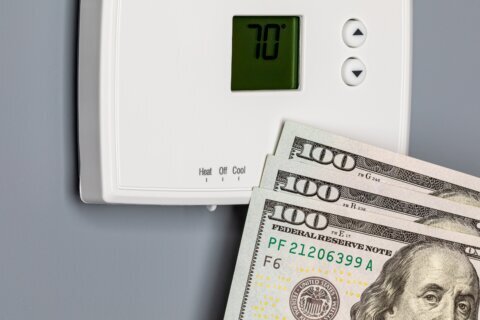This video is no longer available.
Listen live to WTOP for traffic and weather updates on the 8s.
Tropical Storm Debby was downgraded to a tropical depression Thursday afternoon and it’s expected to continue weakening as it moves north this week — but not before it rolls through the D.C. area bringing the risk of flooding and the formation of tornadoes. Here’s what you need to know.
The entire D.C. region is under a tornado watch until 7 a.m. Friday.
A flash flood warning is also in effect in northwestern Fauquier County and western Loudoun County and its surrounding areas until 3:15 a.m. Friday. Between two and four inches of rain have fallen and more is expected to come with the biggest risk around small creeks and streams.
A flash flood warning is also in effect for northwestern Washington County and northeastern Allegany County in western Maryland until 3 a.m.
WTOP Meteorologist Mike Stinneford confirmed a tornado touched down in Goldvein in Fauquier County around 8 p.m. and another around the heart of Warrenton around 8:20 p.m.
Flash flooding is often caused when rain “runs off because the ground is too hard to absorb it,” Stinneford said. “The ground is really dry, almost like an adobe brick, so it’s hard for this rain to soak in.”
Stinneford said these rain-wrapped tornadoes will be especially hard to see at night, so motorists should absolutely avoid driving at all costs.
“Since this is a tropical system, there’s really no threat of lightning either. So you won’t get that advanced warning that we get sometimes with tornadoes, that you’ll see a lot of lightning and thunder, very little going on with this tropical system,” Stinneford said.
Anyone in the path of a possible tornado touchdown should take cover, shelter in place and avoid being near windows as dangerous flying debris will be likely.
The NWS said “torrential rainfall is occurring with this storm, and may lead to flash flooding” around the D.C. area.
Three to 5 inches of rain are expected in counties affected by a flood watch, also issued by the NWS, which extends into western Maryland, southern Virginia and northwestern Virginia. Excessive runoff could cause flooding in rivers, creeks and streams.
Weathering the storm
Local governments are offering sandbags for residents and small businesses that will be affected by the flooding. In Maryland, Prince George’s County residents can pick up four to 10 sandbags until Saturday at three different locations across the county, and Annapolis residents can use their identification to pick up shovels and sandbags at the Donner Parking Lot, at 60 West Street.
In Virginia, Alexandria residents with proof of residency can collect up to five sandbags at 133 S Quaker Lane from 3 p.m. to 7 p.m. on Thursday.
7News First Alert Senior Meteorologist Brian van de Graaff told WTOP the heaviest rain will be coming down Thursday evening and Friday morning, with rain totals reaching 1 to 3 inches in the District.
“We’re looking at the potential for some severe weather early on your Friday morning, including some damaging winds, heavy downpours and the threat for some spin ups, isolated tornadoes, as that spin is in the atmosphere,” van de Graaff said.
The worst of the storm will have passed by Friday afternoon, with skies clearing up in the evening and leaving the parting gift of a cooler weekend in the low to mid-80s.
Earl Stoddard, former director of the Office of Emergency Management and Homeland Security in Montgomery County, told reporters in Wednesday’s briefing: “With a storm system like this, what we’re concerned about is the near-random locations of high intensity rainfalls that overwhelm the local stormwater management systems in that area,” and lead to either street or backyard flooding.
There are areas of the county that flood regularly when heavy storms hit.
“The aptly-named Beach Drive is a common place where we see flooding,” he said.
There are also flood monitors that dot the county with sensors that serve as warnings before actual flooding takes place, said Stoddard. “We have teams around the county making sure those monitors are actively working right now,” he said.
“We will have the Emergency Operations Center actively monitoring during the peak of the storm, certainly Friday into Saturday,” said Stoddard.
- Listen to WTOP online and on the radio at 103.5 FM or 107.7 FM.
- Current traffic conditions
- Weather forecast
- Closings and Delays
- Sign up for WTOP alerts
DC activates emergency operations center
The District activated its Emergency Operations Center in anticipation of Tropical Depression Debby’s impacts.
“Residents are reminded that you should never drive, bike, or walk through floodwaters. Almost half of all flash flood deaths happen in vehicles. When in your vehicle, look out for flooding in low lying areas, at bridges, and at highway dips. As little as 6 inches of water may cause a driver to lose control of their vehicle,” a release read.
The city said, if needed, residents can look for shelter at any low-barrier homeless shelter.
Other tips from D.C. include:
- Sign up for AlertDC at alert.dc.gov and follow AlertDC on X @AlertDC.
- Track weather forecasts from the National Weather Service for up-to-date information on the storm timing and location.
- Call 311 to report downed trees.
- Install protection or move items out of any areas that typically flood.
- Ensure you know where insurance and other important numbers are located (and take pictures of important documents like your insurance cards).
- Check on neighbors who may require assistance if it is safe to do so. This includes individuals with infants, children as well as older adults, people with disabilities and others who may need help.
- If you have a water emergency or a sewer backup, immediately report it to DC Water’s Water and Sewer Emergency Line by calling (202) 612-3400.
- Residents can report clogged or blocked storm drains, or any other issues related to water and sewer service, to DC Water’s Emergency Command Center is available 24-hours a day, seven days a week by phone at (202) 612-3400, or through their online report a problem platform.
Keep yourself safe during flooding:
- Stay off the roads: emergency workers will be assisting people in flooded areas.
- Be aware of areas where floodwaters have receded. Roads may have weakened and could collapse under the weight of a car.
- Stay out of floodwater: Standing water may be electrically charged from underground or downed power lines or contain hazards such as human and animal waste, dangerous debris, contaminates that can lead to illness, or wild or stray animals.
Stay safe after the storm:
- Treat all downed power lines as if they’re live. Do not touch, drive over, or try to move downed power lines. Report downed power lines to 311.
- If your home has flood water inside or around it, don’t walk or wade in it. The water may be contaminated by oil, gasoline, or raw sewage. Never attempt to turn off power or operate circuit breakers while standing in water.
- Be careful when cleaning up. Wear protective clothing, including a long-sleeved shirt, long pants, work gloves and sturdy thick-soled shoes. Do not try to remove heavy debris by yourself. Use an appropriate mask if cleaning mold or other debris. People with asthma and other lung conditions and/or immune suppression should not enter buildings with indoor water leaks or mold growth that can be seen or smelled. Children should not take part in disaster cleanup work.
- Use a generator correctly and safely. Keep generators dry and position them outdoors and well away from any structure. Using a generator incorrectly can lead to dangerous situations, including carbon monoxide poisoning from engine exhaust. If you start to feel sick, dizzy, or weak while using a generator, get fresh air right away.
Virginia prepares for storm damage, National Guard on standby
Virginia Gov. Glenn Youngkin declared a state of emergency for the Commonwealth on Tuesday as the impending weather “could cause transportation difficulties and power outages.” The declaration allows the state to prepare resources to help with dangerous storm conditions and recovery. The Virginia National Guard is standing by, ready to help.
“They will have about 140 of their soldiers ready to go if any need arises,” said Jason Elmore, a spokesman with the Virginia Department of Emergency Management. “Some of those needs may be rescue. They have vehicles that can travel in flooded waters.”
The south-central area of Virginia is expected to see the most rain, upward of 6 to 7 inches, according to forecasts. Elmore said the National Guard is “vital” in this type of situation.
“They have a larger number of people that they can deploy to specific areas, and they can activate pretty quickly,” he added.
Youngkin told WTOP, “Northern Virginia will see a lot of rain. And so I’m just asking everybody, please stay informed, stay alert and have a plan.”
“Let’s stand up together. Let’s lock arms and make sure that we all weather the storm healthy and safely,” he added. “Your car is not a submarine, and let’s use some common sense here.”
Maryland also issued a state of preparedness declaration that coordinates preparations for the storm without declaring a state of emergency.
FORECAST
Steadier rain bands arrive this afternoon, separated by briefer dry breaks as Tropical Depression Debby heads deeper into the Carolinas. Expect standing water in favorable spots for the evening commute.
The Flood Watch will likely get expanded east of Route 15.
Early Friday is also the best risk for widespread heavy rain bands as Debby sweeps up I-81. Within these rain bands, a gusty storm and/or brief tornado spin up is definitely possible. The southeast wind will be breezy, likely gusty along the western shore of the Chesapeake Bay on Friday where coastal flooding is likely.
A northwest wind will start to work toward drying the pavement after about 5 p.m. Friday. We are in for a cooler, less humid and dry weekend following Debby’s passage, thanks to a cold front sweeping everything to the east of our area.
THURSDAY AFTERNOON:
Occasional rain and thunder. Spotty flooding developing later in the day.
Highs: Low 80s
Winds: SE 5-10 mph
THURSDAY NIGHT:
Bands of heavy showers and turning breezy. Flooding expected with a brief tornado or two possible. A few downed trees for the AM commute.
Low: 76 degrees.
Winds: SE increasing to 10-15 mph, 20-25 mph along the western shore of the Bay
FRIDAY:
Occasional rain, thunder, gusty winds and tornado or two possible. Flooding likely. Rain ends late afternoon and sun returns.
Highs: Low 80s
Winds: SE 10-15 mph, 20-30 mph along the Bay
WEEKEND:
Mostly sunny, cooler and less humid. Low: 60s with highs in the low to mid 80s.
CURRENT CONDITIONS
Outages
Get breaking news and daily headlines delivered to your email inbox by signing up here.
© 2024 WTOP. All Rights Reserved. This website is not intended for users located within the European Economic Area.









